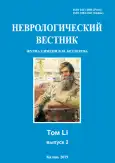Emotional disorders in children with breath-holding spells and in their mothers
- Authors: Polskaya A.V.1, Chutko L.S.2
-
Affiliations:
- Belgorod Children’s Regional Hospital
- Institute of Human Brain, Russian Academy of Sciences
- Issue: Vol LI, No 2 (2019)
- Pages: 61-65
- Section: Original study arcticles
- URL: https://journals.rcsi.science/1027-4898/article/view/15664
- DOI: https://doi.org/10.17816/nb15664
- ID: 15664
Cite item
Full Text
Abstract
The aim of the research was to study the emotional characteristics of children with breath-holding spells (BHS) and their mothers. The results of a survey of 80 young children examined for BHS are presented. To assess their emotional characteristics, we used the questionnaire of A.I. Zakharov, the questionnaire of G.P. Lavrentieva and T.M. Titarenko «Level of anxiety of a child», as well as the anxiety test of R. Temml, V. Amen, M. Dorka. The results of this study showed that children with BHS revealed a higher level of anxiety compared with healthy children in the control group. As the methods of research of the mother’s emotional characteristics was used the following: «Questionnaire for detecting signs of autonomic disorders» by A. M. Wayne, Personal scale manifestations of anxiety by A. J. Teylor in the adaptation of T. A. Nemchinova, State-Trait Anxiety Inventory of Ch.D. Spilberger in adaptation of Y.L. Hanin, Toronto Alexithymia Scale (TAS-26), adapted at the Research Institute of Bekhterev (St. Petersburg). According to the results of the research, most mothers of children with BHS had emotional disorders (high level of anxiety, alexithymia), which suggests the presence of a psychosomatic component in the Genesis of this disease.
Keywords
Full Text
##article.viewOnOriginalSite##About the authors
Alina V. Polskaya
Belgorod Children’s Regional Hospital
Author for correspondence.
Email: chutko5@mail.ru
Russian Federation, 308036, Belgorod, Gubkin street, 44
Leonid S. Chutko
Institute of Human Brain, Russian Academy of Sciences
Email: chutko5@mail.ru
Russian Federation, 197376, St. Petersburg, Academician Pavlov street, 9
References
- Алекситимия и методы ее определения при пограничных психосоматических расстройствах: Метод. пособие / Психоневрол. ин-т им. В. М. Бехтерева; [Авт.-сост. Д.Б. Ересько и др.]. СПб.: Психоневрол. ин-т, 1994. 16 с.
- Белоусова Е.Д. Аффективно-респираторные приступы // Врач. 2011. № 8. С. 59–61.
- Гузева В.И. Эпилепсия и неэпилептические пароксизмальные состояния у детей. М.: Медицинское информационное агенство. 2007. 568 с.
- Гузева В.И., Гузева О.В., Гузева В.В. Роль видео-ЭЭГ-мониторинга в диагностике эпилептических и неэпилептических пароксизмальных состояний у детей // Эпилепсия и пароксизмальные состояния. 2010. № 2. С.12–19.
- Диагностика эмоционально-нравственного развития / Сост. и ред. И.Б. Дерманова. СПб.: Речь. 2002. 171 с.
- Захаров А. И. Предупреждение отклонений в поведении ребенка. 3-е изд., испр. СПб.: Союз, 1997. 222 с.
- Коростовцев Д. Д., Гузева В. И., Фомина М.Ю. и др. Неэпилептические пароксизмальные расстройства у детей. Уч.-метод. пособие. СПб.: Изд. СПбГМА, 2006. 40 с.
- Пальчик А.Б. Понятишин А.Е. Неэпилептические пароксизмы у грудных детей. М.: МЕДпреcс-информ, 2015. С. 100–111.
- Ammon H. Psychoanalyse und Psychosomatik. Munchen: Piper, 1974.
- De Myer W. Breath-holding spells. In: Current Management in Child Neurology. 3rd ed Bernard L Maria., editor. Ed. BC Decker; PMPH-USA, 2005. P.353–355.
- Di Mario F. J., Burleson J. A. Autonomic nervous system function in severe breath-holding spells // Pediatric Neurology. 1993. Vol. 9(4). P. 268–274.
- Di Mario F.J., Sarfarazi M. Family pedigree analysis of children with severe breath-holding spells // Journal of Pediatrics. 1997. Vol. 130(4). P. 647–651.
- Essau С.A. Anxiety in children: when is it classed as a disorder that should be treated? // Expert Rev.Neurotherapeutics. 2007. Vol.7 (8). P. 909–911.
- Gauk E.W., Kidd L., Prichard J.S. Mechanism of seizures associated with breath-holding spells // N Engl J Med 1963. Vol. 268. P. 1436–1441.
- Goldman R.D. Breath-holding spells in infants // Can Fam Physician. 2015. Vol. 61(2). P. 149–150.
- Hinman A., Dickey L.B. Breath-holding spells. A review of the literature and eleven additional cases // Am J Dis Child 1956. Vol. 91. P. 23–33.
- Leung A.K.C., Leung A.A.M., Wong A.H.C., Hon K.L. Breath-Holding Spells in Pediatrics: A Narrative Review of the Current Evidence // Curr Pediatr Rev. 2019. Vol.15 (1). P. 22–29.
- Mahler M. S., Pine F., Bergman A. The psychological birth of the human infant. New York: Basic Books, 1975. P. 269.
- Mocan H., Yildiran A., Orhan F., Erduran E. Breath holding spells in 91 children and response to treatment with iron // Arch. Dis. Child. 1999. Vol. 81(3). P. 261–262.
- Obeid M., Mikati M.A. Expanding spectrum of paroxysmal events in children: potential mimickers of epilepsy // Pediatr Neurol. 2007. Vol. 37. P. 309–316.
- Roddy S.M. Breath-holding spells and reflex anoxic seizures. In: Swaiman K.F., Ashwal S., Ferriero D.M. et al, eds. // Swaiman’s Pediatric Neurology: Principles and Practice. 6th ed. Philadelphia, PA: Elsevier,. 2017. chap 85.
- Sawires H., Botrous O. Double-blind, placebo-controlled trial on the effect of piracetam on breath-holding spells // Eur. J. Pediatr. 2012. Vol. 171(7). P.1063–1067.
- Silbert P.L., Gubbay S. Familial cyanotic breath-holding spells // J. Pediatr. Child. Health. 1992. Vol. 28(3). P. 254–256.
Supplementary files






